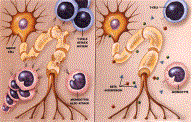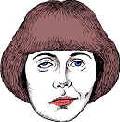|
Outcome & Case
Data - Osteopathic
Manipulative Treatment

NEUROLOGICAL
PROBLEMS
MULTIPLE SCLEROSIS

Yates
HA , Vardy TC , Kuchera ML , Ripley BD , and Johnson JC
Effects of osteopathic manipulative treatment and concentric and eccentric
maximal-effort exercise on women with multiple sclerosis: a pilot study. JAOA:
The Journal of the American Osteopathic Association 2002 May;102(5):267-275,
quiz 299-300
Findings indicate
that osteopathic manipulative treatment (OMT) combined with maximal-effort
exercise (MEE) significantly increases strength and ambulatory levels while not
increasing fatigue in female patients with MS who have low to medium impairment.
Qualitative data show that this intervention also produces beneficial effects in
activities of daily living.
(Thank
you to Lydia Kibiuk - http://web.sfn.org/content/Publications/BrainBriefings/ms.html
for allowing me use of her graphic image)
********************************************************
Yates
HA , Vardy TC , Kuchera ML , Ripley B , and Johnson JC
Prolonged effects of maximal effort exercise and osteopathic manipulative
treatment on women with multiple sclerosis: a pilot study. Journal of
Osteopathic Medicine (Australia) 2002 Apr;5(1):42-43
The combined effect of MEE and OMT significantly
increases strength and ability to walk in female MS patients and does not
increase fatigue, a major symptom of MS. The effects on walking and strength
were maintained through a 9-month follow-up period.
********************************************************
STROKE
 Maxwell
S
Maxwell
S
The
use of OMT in stroke rehabilitation. The
AAO Journal: A Publication of the American Academy of Osteopathy 1999
Spr;9(1):18-20
The
survivors of a stroke lead lives ranging from normal full function to a high
degree of permanent impairment. The case and discussion presented illustrate how
osteopathic physicians can increase the quality of life for people left with
musculoskeletal disabilities and decreased motor function in the post-acute care
setting by using OMT treatment strategies to address some of
the complications of strokes.
(Thanks to Prof. Nancy Rothwell at http://www.biomed2.man.ac.uk/biology/ns/njr/what2.html
for allowing me use of their graphic image)
********************************************************
PERIPHERAL NEUROPATHY
 Larson
NJ , Walton MW , Hunt HH , and Kelso AF Larson
NJ , Walton MW , Hunt HH , and Kelso AF
A double-blind clinical study of the effects of manipulative treatment of
patients with peripheral nerve complaints [meeting abstract]
JAOA: The Journal of the American Osteopathic Association 1976 Nov;76(3):209
The
patients used in the primary research project were those whose peripheral nerve
complaints were not associated with other disease problems. The study showed
that a good therapeutic response was obtained by treatment and that the
temperature of
the affected limb was changed as a result of the manipulation.
(Thanks to Support Your Back
- www.supportyourfeet.com
for allowing me use of their graphic image)
********************************************************
BELL’S PALSY
 Hallihan
MR , Walton FC Sr , McConnell JE , and Wyatt WE Hallihan
MR , Walton FC Sr , McConnell JE , and Wyatt WE
A prospective clinical study on the efficacy of osteopathic manipulative
treatment for Bell's palsy patients. JAOA:
The Journal of the American Osteopathic Association 1984 Sep;84(1):75
This
study showed improvement in the symptoms of Bell’s Palsy associated with a response of the palpatory findings
and changes in circulation to the affected
areas.
|



